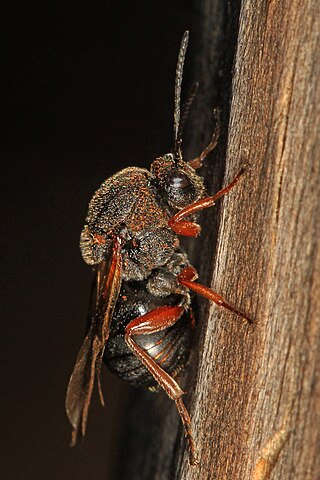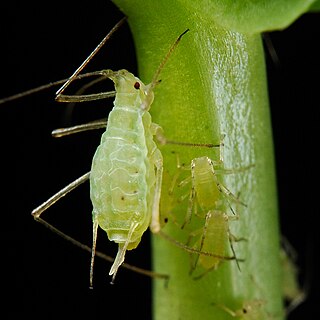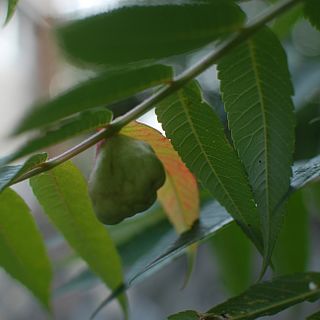Related Research Articles

Asexual reproduction is a type of reproduction that does not involve the fusion of gametes or change in the number of chromosomes. The offspring that arise by asexual reproduction from either unicellular or multicellular organisms inherit the full set of genes of their single parent and thus the newly created individual is genetically and physically similar to the parent or an exact clone of the parent. Asexual reproduction is the primary form of reproduction for single-celled organisms such as archaea and bacteria. Many eukaryotic organisms including plants, animals, and fungi can also reproduce asexually. In vertebrates, the most common form of asexual reproduction is parthenogenesis, which is typically used as an alternative to sexual reproduction in times when reproductive opportunities are limited. Komodo dragons and some monitor lizards can reproduce asexually.

Birth is the act or process of bearing or bringing forth offspring, also referred to in technical contexts as parturition. In mammals, the process is initiated by hormones which cause the muscular walls of the uterus to contract, expelling the fetus at a developmental stage when it is ready to feed and breathe.

Aphids are small sap-sucking insects and members of the superfamily Aphidoidea. Common names include greenfly and blackfly, although individuals within a species can vary widely in color. The group includes the fluffy white woolly aphids. A typical life cycle involves flightless females giving live birth to female nymphs—who may also be already pregnant, an adaptation scientists call telescoping generations—without the involvement of males. Maturing rapidly, females breed profusely so that the number of these insects multiplies quickly. Winged females may develop later in the season, allowing the insects to colonize new plants. In temperate regions, a phase of sexual reproduction occurs in the autumn, with the insects often overwintering as eggs.
Heterogamy is a term applied to a variety of distinct phenomena in different scientific domains. Usually having to do with some kind of difference, "hetero", in reproduction, "gamy". See below for more specific senses.

Hemiptera is an order of insects, commonly called true bugs, comprising over 80,000 species within groups such as the cicadas, aphids, planthoppers, leafhoppers, assassin bugs, bed bugs, and shield bugs. They range in size from 1 mm (0.04 in) to around 15 cm (6 in), and share a common arrangement of piercing-sucking mouthparts. The name "true bugs" is often limited to the suborder Heteroptera.

The Aphididae are a very large insect family in the aphid superfamily (Aphidoidea), of the order Hemiptera. These insects suck the sap from plant leaves. Several thousand species are placed in this family, many of which are considered plant/crop pests. They are the family of insects containing most plant virus vectors with the green peach aphid being one of the most prevalent and indiscriminate carriers.

Gall wasps, also traditionally calledgallflies, are hymenopterans of the family Cynipidae in the wasp superfamily Cynipoidea. Their common name comes from the galls they induce on plants for larval development. About 1,300 species of this generally very small creature are known worldwide, with about 360 species of 36 different genera in Europe and some 800 species in North America.

The witch-hazel cone gall aphid is a minuscule insect, a member of the aphid superfamily, whose presence on a witch-hazel plant is easily recognizable by a conical gall structure. The gall is green at first, then turns bright red. This gall, rich in nutrients, provides both food and shelter for the female aphid.

Parthenogenesis is a natural form of asexual reproduction in which growth and development of an embryo occur directly from an egg, without need for fertilisation. In animals, parthenogenesis means development of an embryo from an unfertilized egg cell. In plants, parthenogenesis is a component process of apomixis. In algae, parthenogenesis can mean the development of an embryo from either an individual sperm or an individual egg.
Gyrinicola batrachiensis are nematode parasites that are members of the order Oxyurida. Members of this order are also known as pinworms. These organisms are nematodes that feed on micro-particles in the gut of vertebrates and invertebrates. Oxyurida is further separated into two superfamilies: Oxyuroidea and Thelastomatoidea, which are parasites of vertebrates and invertebrates respectively. Oxyuroidea is composed on three families: Pharyngodonidae; parasites of herbivorous vertebrates, and Oxyuridae and Heteroxynematidae; parasites of mammals and some birds.

Myzus persicae, known as the green peach aphid, greenfly, or the peach-potato aphid, is a small green aphid belonging to the order Hemiptera. It is the most significant aphid pest of peach trees, causing decreased growth, shrivelling of the leaves and the death of various tissues. It also acts as a vector for the transport of plant viruses such as cucumber mosaic virus (CMV), potato virus Y (PVY) and tobacco etch virus (TEV). Potato virus Y and potato leafroll virus can be passed to members of the nightshade/potato family (Solanaceae), and various mosaic viruses to many other food crops.

The black bean aphid is a small black insect in the genus Aphis, with a broad, soft body, a member of the order Hemiptera. Other common names include blackfly, bean aphid, and beet leaf aphid. In the warmer months of the year, it is found in large numbers on the undersides of leaves and on the growing tips of host plants, including various agricultural crops and many wild and ornamental plants. Both winged and wingless forms exist, and at this time of year, they are all females. They suck sap from stems and leaves and cause distortion of the shoots, stunted plants, reduced yield, and spoiled crops. This aphid also acts as a vector for viruses that cause plant disease, and the honeydew it secretes may encourage the growth of sooty mould. It breeds profusely by live birth, but its numbers are kept in check, especially in the later part of the summer, by various predatory and parasitic insects. Ants feed on the honeydew it produces, and take active steps to remove predators. It is a widely distributed pest of agricultural crops and can be controlled by chemical or biological means. In the autumn, winged forms move to different host plants, where both males and females are produced. These mate and the females lay eggs which overwinter.

Acyrthosiphon pisum, commonly known as the pea aphid, is a sap-sucking insect in the family Aphididae. It feeds on several species of legumes worldwide, including forage crops, such as pea, clover, alfalfa, and broad bean, and ranks among the aphid species of major agronomical importance. The pea aphid is a model organism for biological study whose genome has been sequenced and annotated.

Rhopalosiphum maidis, common names corn leaf aphid and corn aphid, is an insect, and a pest of maize and other crops. It has a nearly worldwide distribution and is typically found in agricultural fields, grasslands, and forest-grassland zones. Among aphids that feed on maize, it is the most commonly encountered and most economically damaging, particularly in tropical and warmer temperate areas. In addition to maize, R. maidis damages rice, sorghum, and other cultivated and wild monocots.

Phylloxeridae is a small family of plant-parasitic hemipterans closely related to aphids with only 75 described species. This group comprises two subfamilies and 11 genera with one that is fossil. The genus type is Phylloxera. The Phylloxeridae species are usually called phylloxerans or phylloxerids.

Aphis craccivora, variously known as the cowpea aphid, groundnut aphid or black legume aphid, is a true bug in the family Aphididae. Originally of probable Palearctic origin, it is now an invasive species of cosmopolitan distribution.

Melaphis rhois is an aphid species first identified by Asa Fitch in 1866. Known as the staghorn sumac aphid, it is the only species in the genus Melaphis. It is a type of woolly aphid and one of the few aphids that induce the formation of galls.

Sitobion avenae, the English grain aphid, is an aphid in the superfamily Aphidoidea in the order Hemiptera. It is a true bug and sucks sap from plants. It lives on grasses, sedge and rushes and can be a significant pest of cereals.
Paracletus cimiciformis is a species of aphid with a complex life cycle. Its primary host plant is Pistacia and its secondary host is a grass, where it is present on the roots. Here it is associated with an ant and part of its life cycle is spent in the ant's nest.
Elatobium abietinum, commonly known as the spruce aphid or green spruce aphid, is a species of aphid in the subfamily Aphidinae that feeds on spruce, and occasionally fir. It is native to Northern, Central and Eastern Europe and has spread to Western Europe, North America and elsewhere.
References
- Kindlmann, P.; Dixon, A. F. G. (1989). "Developmental constraints in the evolution of reproductive strategies: telescoping of generations in parthenogenetic aphids". Functional Ecology. 3 (5): 531–537. doi:10.2307/2389567. JSTOR 2389567.